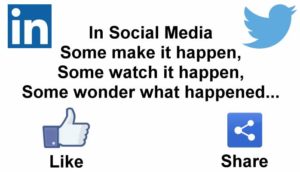 The good news – you’re here and reading this. Congratulations, you’ve taken the first steps in Social Media. Based on a recent Pew Research poll, in the age group 30-49, 82% are engaged with social networking sites and between ages 50 and 64 that number drops to 65%.
The good news – you’re here and reading this. Congratulations, you’ve taken the first steps in Social Media. Based on a recent Pew Research poll, in the age group 30-49, 82% are engaged with social networking sites and between ages 50 and 64 that number drops to 65%.
Social media falls into several categories involving your personal and professional life. This article will focus more on the professional side. However clearly, for personal, Facebook leads the pack. As of September 2013, 71% of online adults are on Facebook. Facebook is typically for your personal life, and for B2C (Business to Consumer) marketing. And that is about all we’ll say in that regard. This article will focus more on your professional practice and the B2B (Business to Business) aspects of social media.
For business to business social media, there are two clear leaders, Linked-In and Twitter. The breakdown is close with 22% of adults using LinkedIn compared with 19% using Twitter.
Linked-In is the world’s largest professional network with over 300,000,000 participants. The primary purpose of Linked-In is to manage your network of relationships, both personal and professional, but focusing more on the professional side. Linked-In gives you a place to track the people you’ve come to know professionally, regardless of their current company. Linked-In is the address book that never goes out of date. While many view Linked-In as a job search tool, that’s a very superficial view. More important, Linked-In is a resource to keep in contact, maintain and nurture your connections over time. Linked-In enables you to share your expertise, for whatever gain that may bring. Linked-In also enables you to research companies, access their employees, make new connections, and stay current with their latest news, join groups and collaborate online.
Twitter has over 284,000,000 active users (out of 982,000,000 total accounts) and delivers a very different purpose. Twitter is like a flowing river if information. As a user, you can choose to add to the flow by tweeting, or sieve information out of the flow by either following specific Twitter accounts, or by searching Twitter streams with a set of Keywords. This is a very important concept to understand.
Twitter users will typically fall into two camps, those that generate content, and those that read the content. 44% of Twitter users have never sent a tweet, and the vast majority of users tweet less than once per month. Only 17% of Twitter users tweet more than once per day. The main benefit of Twitter is the opportunity to follow the streams of information that are most important to you, always seeing that content when you log into your account. The other major benefit is that you can search, ideally with hash tags (#SearchTerms) to quickly access key content of interest (dropping a sieve into the flow of information). While you can search on anything, the use of hash tags will direct you to content intentionally categorized by the author (#ReportGen for example, the Dream Report hash tag for all content industrial report generator related).
In Social Media and Technology – some make things happen, some watch things happen and some wonder what happened. Which are you?
At this point, there is no question that social media should be a valuable part of your professional life. If you’re in the camp of the 44% that reads but have never sent a tweet (let’s broaden that to include Status updates, Like a post, and Post original content), then you have some easy room for improvement, you’ll be delivering value to those around you, and you’ll be taking a small step to enhancing your professional reputation.
So get out there and Share, Like and Post. Feel free to start with this article. 🙂
References:
http://www.pewinternet.org/fact-sheets/social-networking-fact-sheet/
https://about.twitter.com/company
http://www.internetlivestats.com/twitter-statistics/
http://www.businessinsider.com/twitter-user-statistics-2014-4

